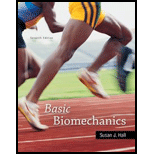
Basic Biomechanics
7th Edition
ISBN: 9780073522760
Author: Susan J Hall
Publisher: McGraw-Hill Education
expand_more
expand_more
format_list_bulleted
Concept explainers
Textbook Question
Chapter 12, Problem 8IP
A ball dropped on a surface from a 2-m height bounces to a height of 0.98 m. What is the coefficient of restitution between ball and surface? (Answer: 0.7)
Expert Solution & Answer
Want to see the full answer?
Check out a sample textbook solution
Chapter 12 Solutions
Basic Biomechanics
Ch. 12 - How much force must be applied by a kicker to give...Ch. 12 - A high jumper with a body weight of 712 N exerts a...Ch. 12 - What factors affect the magnitude of friction?Ch. 12 - If s between a basketball shoe and a court is...Ch. 12 - A football player pushes a 670-N blocking sled....Ch. 12 - Lineman A has a mass of 100 kg and is traveling...Ch. 12 - Prob. 7IPCh. 12 - A ball dropped on a surface from a 2-m height...Ch. 12 - A set of 20 stairs, each of 20-cm height, is...Ch. 12 - A pitched ball with a mass of 1 kg reaches a...
Ch. 12 - Identify three practical examples of each of...Ch. 12 - Prob. 2APCh. 12 - A 2-kg block sitting on a horizontal surface is...Ch. 12 - Explain the interrelationships among mechanical...Ch. 12 - Prob. 5APCh. 12 - A 108 cm, 0.73-kg golf club is swung for 0.5 s...Ch. 12 - A 6.5-N ball is thrown with an initial velocity of...Ch. 12 - Prob. 8APCh. 12 - Using the principle of conservation of mechanical...Ch. 12 - Prob. 10AP
Knowledge Booster
Learn more about
Need a deep-dive on the concept behind this application? Look no further. Learn more about this topic, bioengineering and related others by exploring similar questions and additional content below.Recommended textbooks for you
 Principles Of Radiographic Imaging: An Art And A ...Health & NutritionISBN:9781337711067Author:Richard R. Carlton, Arlene M. Adler, Vesna BalacPublisher:Cengage Learning
Principles Of Radiographic Imaging: An Art And A ...Health & NutritionISBN:9781337711067Author:Richard R. Carlton, Arlene M. Adler, Vesna BalacPublisher:Cengage Learning Nutrition Through The Life CycleHealth & NutritionISBN:9781337919333Author:Brown, Judith E.Publisher:Cengage Learning,
Nutrition Through The Life CycleHealth & NutritionISBN:9781337919333Author:Brown, Judith E.Publisher:Cengage Learning,





Principles Of Radiographic Imaging: An Art And A ...
Health & Nutrition
ISBN:9781337711067
Author:Richard R. Carlton, Arlene M. Adler, Vesna Balac
Publisher:Cengage Learning

Nutrition Through The Life Cycle
Health & Nutrition
ISBN:9781337919333
Author:Brown, Judith E.
Publisher:Cengage Learning,
Chapter 7 - Human Movement Science; Author: Dr. Jeff Williams;https://www.youtube.com/watch?v=LlqElkn4PA4;License: Standard youtube license